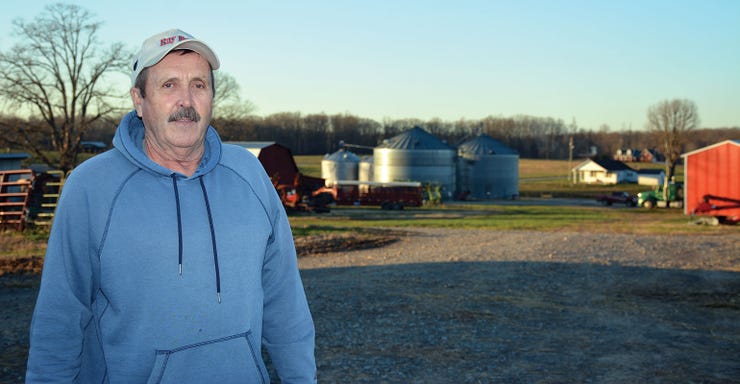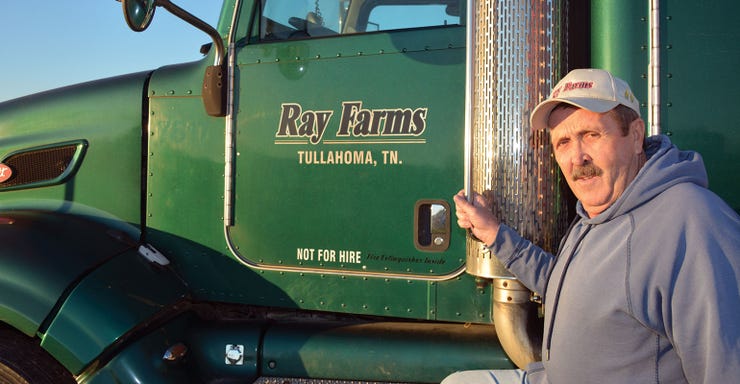
"Cows come first."
That's the way Jerry Ray balances labor on his diversified Coffee County, Tenn., livestock and grain farm.
He admits that concentrating on his stocker cattle operation sometimes takes away from wheat, corn and soybeans.
"Time is my limiting factor," Ray said on a raw, January day that struggled to push above the freezing mark. "It takes two people four hours a day just to feed the cattle," he said. "We have to manage cattle health. Then we can go to the field.
Full-time job
"The cattle operation is a full-time job. We are constantly moving cattle in and out."
He buys 500-pound steers, weaned and vaccinated. "It's a lot easier that way," he says. He sells at 850 pounds with a 2.5-pound average daily gain.
He delivers two tractor trailer-loads a month to a nearby cattle company. And he brings stockers in almost every week. "I have from 500 to 600 head on the farm all the time," he said. "Last year we moved 1,400."
Winter is not bad, Ray says. The crunch comes with row crop planting and harvest. "Sometimes we are not as timely as we need to be with row crops."
Still, he makes good yields — 170-bushel corn, 55-bushel soybeans and 55-bushel wheat last year (an off year for wheat because of wet weather).
Efficiency
He's streamlined row crop practices as much as possible to accommodate the cattle. He stores corn (55,000-bushel capacity), has trucks to deliver grain to market, no-tills 100 percent of his row crop acreage (700 corn, 700 soybeans and 300 wheat double-cropped with beans).
He used a 30-foot planter to seed wheat last fall instead of a 15-foot drill. "I cover twice as many acres and get better seed-to-soil contact," he says.
He expects yield to be as good as with a drill but is uncertain about straw. He bales wheat straw, feeds about half to the cattle and sells half at $4 a square bale to landscape companies. "If it weren't for the straw, I'm not sure I'd continue growing wheat. It has gotten almost as expensive to grow as corn."
The economic advantage of the cattle operation depends on two factors — available land and available feed supply.
"We are not blessed with good row crop soils in this area," Ray says. "Some acreage in the area should not be in row crops. We have a lot of small fields; my largest field is 160 acres and my smallest is 5 acres."
Availability of that good acreage is diminishing, too. "For 40 years we could lease land on a handshake," Ray says. "As that generation disappears, the property splits among heirs and they sell off. I keep cattle only on acres I own."
Feed source
The feed source makes cattle operations attractive. Ray buys a liquid by-product from the Jack Daniels distillery, 6 miles from his Tullahoma, Tenn., farm.
"I pay 24 cents a ton," Ray says, "plus the cost of hauling it."
The product is 90 percent water; the distilling process takes the energy out but leaves about 30 percent protein.
"I add 2.5 pounds of corn to 20 gallons of the distiller by-product per head per day."
He feeds about 5% of the corn he grows. He sells or stores the rest. "The Jack Daniels feed is so cheap I use it and sell my corn."

Storage
Good gains
That ration, plus some hay, allows Ray to get 2.5 pounds average daily gain.
He delivers steers in bulk, too, hauling those two tractor trailer-loads to the cattle company twice a month. "We get an extra 10 cents a pound more per load," he says.
"We couldn't do this without the feed source," he adds. But hauling the liquid eats a lot of time. "We haul it every day. Jack Daniels uses from 15,000 to 20,000 bushels of corn every day and have to get rid of the by-product. They also sell a dry feed, too. We buy a little of that."
He mixes the dry feed with corn and adds calcium carbonate and minerals in a pre-mix, which he buys in bulk and mixes himself, saving $100 a ton over buying it ready-mixed.
"We can only buy so much of the distillers' grain," Ray adds. "Cattle producers in the area each have an allotment."
He grazes cattle on some of his cover crop acreage (fields that are fenced). "We have about one-third of our row crop fields in cover crops. The cattle seem to do well on those fields. We were a little concerned about yield loss, but we haven't seen any compaction."

Trucks
Spreads labor
The cattle operation provides opportunities for Ray's labor force, too. "Labor is an issue here, as it is across farm country," Ray says. "Cattle help us keep labor year-round. During planting or harvest season, on rainy days, we can always work cattle."
The cattle operation provides nutrients to row crops. "We scrape the lots and spread the manure on the fields. We also buy ashes from Jack Daniels and spread that on row crop acres. We get a lot of potassium and lime from the ashes."
Ray says diversification offers his operation a lot of flexibility but adds that the proximity to a distillery makes cattle a stable enterprise. "That's why we have so many cattle operations in this area."
He adds that the farm was once even more diversified, with a hog operation and tobacco. He ran a cow-calf operation for a time but found the distillery product was not suitable for mama cows and calves.
Improving overall operation efficiency is a priority. "We may need to let some of the more marginal row crops acreage go," he says. "We try to be as timely as possible and time management is an issue."
At 66 years old, Ray, who was the 2019 Tennessee Farmer of the Year, says planting and harvesting into the early morning hours are harder than they used to be. "I try to take it a little easier and don't run all night."
About the Author(s)
You May Also Like






